AI App Development: Comprehensive Guide for Business Leaders
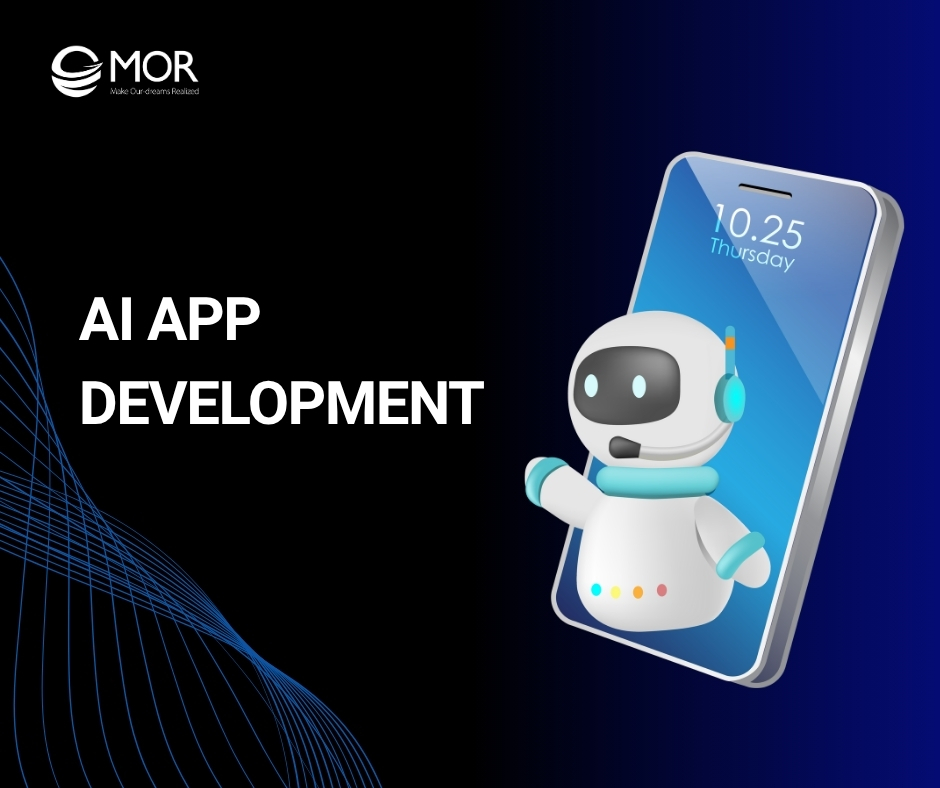
The demand for AI app development is growing as businesses race to automate tasks, predict outcomes, and deliver smarter user experiences. Yet many still struggle with high costs, technical complexity, and finding the right AI app developer. This MOR Software’s guide will walk you through everything, from strategy to cost, to help you build scalable, intelligent AI-powered apps.
What Is AI App Development?
AI app development is the process of designing and creating software that applies AI automation to handle tasks that once depended on human reasoning. This approach combines coding expertise with modern platforms like low-code and no-code systems to speed up delivery and make AI more accessible for all types of organizations. Many businesses now explore AI in app development to strengthen automation and decision-making across their workflows.
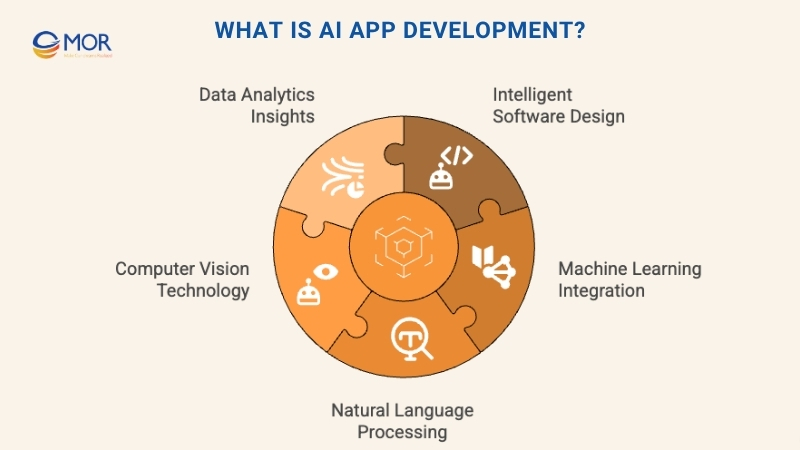
These intelligent applications rely on technologies such as machine learning, natural language processing, computer vision, and data analytics. Together, these components allow systems to learn, adapt, and produce meaningful insights without constant human control. Companies can now create mobile app with AI tools that automate processes, improve accuracy, and deliver smarter outcomes.
Some of the core traits found in modern AI-driven applications include:
- Smart integration: Intelligent apps use components like predictive analytics, NLP, or image recognition to make interactions smoother and results more accurate.
- Automation and productivity: They save time by managing repetitive actions and simplifying daily operations.
- Personalized experiences: Algorithms learn from user data to customize AI content strategy, services, or recommendations.
- Informed decision-making: Businesses can base choices on real-time analysis, not assumptions.
You already use many examples of AI for app development in daily life:
- Voice assistants: Siri, Alexa, and Google Assistant process speech and respond naturally.
- Visual recognition tools: Google Photos and face ID systems classify and identify images automatically.
- Generative AI platforms: ChatGPT and similar apps produce text or responses based on user input.
- Predictive finance apps: Banking and investment tools forecast trends and suggest better financial actions.
In short, AI app development transforms ordinary software into systems that think, respond, and improve with every interaction.
Business Benefits Of AI App Development
Investing in AI app development often delivers faster returns than expected. Recent data from Constant Contact reveals that most companies adopting AI tools and automation have seen lower costs and improved productivity across departments. The longer these systems run, the more value they generate through learning and process refinement.
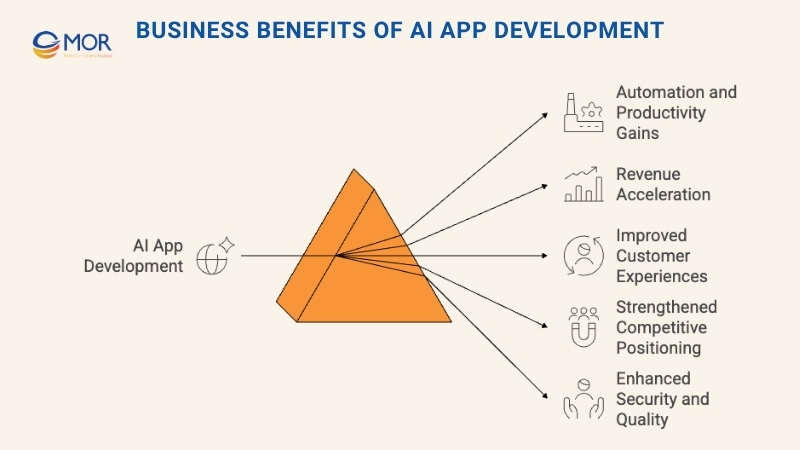
Here’s what their research highlighted:
- About 60% of businesses using AI or automation report noticeable time savings and higher efficiency.
- 70% say they’re willing to pay more for software that includes built-in AI features.
- One-third claim they save more than 40 minutes each week on routine work.
These results show why AI app development services are becoming a priority for forward-thinking businesses. When planned and implemented properly, AI-powered applications can transform how teams operate, make decisions, and scale growth.
Automation And Productivity Gains
According to McKinsey, artificial intelligence could contribute between $2.6 trillion and $4.4 trillion in annual global value, driving productivity by up to 40%. The potential impact grows even more when these capabilities are built directly into business applications.
This improvement stems from AI automating repetitive and time-consuming tasks like data processing, scheduling, and support tickets, freeing employees to focus on strategy and innovation. Beyond that, AI app development enables smarter data analysis, pinpointing inefficiencies and suggesting ways to improve logistics, supply chain flow, or resource consumption. For organizations looking to AI create application solutions that drive measurable efficiency, these insights can be a powerful competitive edge.
Revenue Acceleration
When applied strategically, AI app development can drive steady revenue gains of 1–5% per year once adopted at scale. Industries like retail, finance, and healthcare have seen the strongest impact, as data-driven intelligence transforms how they attract and retain customers.
The real value lies in AI service providers’s ability to detect trends and anticipate customer behavior. By analyzing large datasets, it helps companies fine-tune marketing campaigns, tailor pricing strategies, and guide product innovation toward what buyers truly want.
Beyond forecasting, intelligent systems also reveal untapped cross-selling and upselling opportunities. This deeper understanding of customer preferences enables businesses to improve engagement and increase the average order value, turning every transaction into a smarter growth opportunity.
Better Customer Experiences
Intelligent automation in customer-facing processes can raise productivity by as much as 30–45% while cutting response times and manual effort. With AI app development, these improvements extend far beyond basic efficiency gains.
Modern systems powered by generative models elevate personalization and engagement. They study user behavior, preferences, and previous interactions to create dynamic recommendations and tailored content that feel natural and relevant. Businesses that build an app with AI gain the ability to adapt instantly to each customer’s needs.
Meanwhile, AI chatbots and virtual assistants deliver around-the-clock support, answering questions and resolving problems in seconds. The result is faster service, stronger engagement, and higher overall satisfaction, a user experience that keeps customers coming back.
Competitive Positioning
With AI app development, companies gain faster and more accurate visibility into market movements and customer behavior. These systems process massive data streams, uncovering insights that traditional analytics would miss. For business leaders, that means clearer strategic direction and a sharper edge over competitors.
AI diversity also fuels innovation by identifying gaps in current offerings and suggesting product or service enhancements. This continuous feedback loop helps organizations evolve with changing market demands instead of reacting to them later.
Security And Quality Improvements
Intelligent algorithms can track and interpret real-time data from multiple sources to identify fraud, suspicious behavior, or cyber threats before they cause harm. These automated checks strengthen protection while reducing the manual workload on IT teams.
In production environments, AI systems now serve as digital inspectors, detecting flaws or inconsistencies with far greater precision than humans. This blend of automation and accuracy helps businesses maintain top-tier quality standards, minimize waste, and protect their reputation.
How Long Does It Take To Develop An AI App?
The timeline for AI app development can range from just a few hours to several months or even longer. The exact duration depends on data quality, model complexity, and whether the solution is built from scratch or based on existing frameworks. Every project has its own pace shaped by both technical and strategic demands.
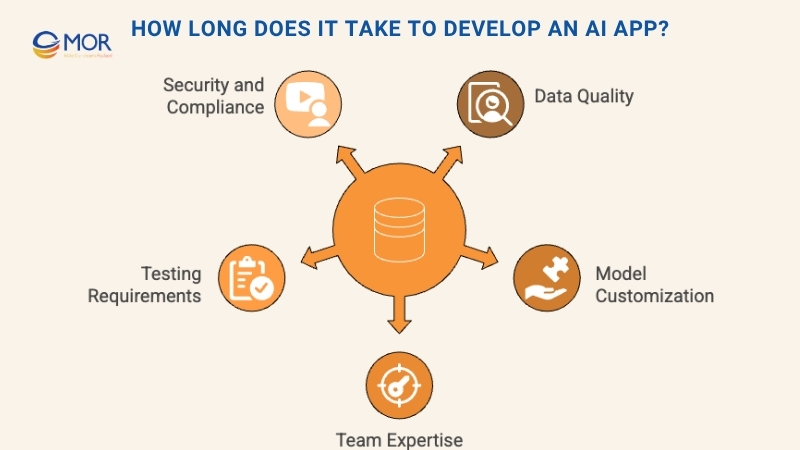
A few factors that heavily influence development time include:
- The degree of ml model customization required
- The expertise and coordination of your AI app developers
- Team size and project management structure
- The scope of testing needed to guarantee performance and reliability
- Security, privacy, and compliance requirements
- The depth and diversity of app features and integrations
Working with an experienced AI app developer helps balance speed, accuracy, and scalability, ensuring the finished product is not only functional but built for long-term success.
Top Industries Benefiting From AI App Development
Year after year, AI app development continues to attract growing investment as businesses realize its potential for real-world impact. While many organizations are still learning how to build an app with AI, several industries have already made major progress using intelligent solutions to scale operations and gain measurable results.
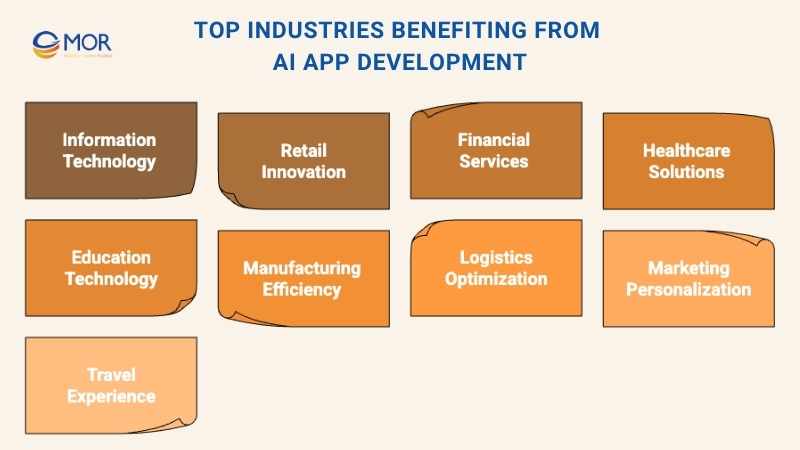
IT
In the IT sector, artificial intelligence supports workflow automation, strengthens cybersecurity, and accelerates product innovation. Developers apply AI for app development to optimize workflows, monitor systems, and predict infrastructure needs with greater precision. A standout example is Google, which integrates AI across nearly all its services, from Gmail’s predictive typing to DeepMind’s work on sustainable computing. That same initiative helped Google cut data center cooling costs by an impressive 40%, proving how advanced AI systems can improve both performance and efficiency.
Retail
In retail, AI app development reshapes how customers browse, buy, and interact with brands. Intelligent systems deliver personalized recommendations, anticipate demand, and streamline checkout for a smoother shopping journey.
Amazon demonstrates this perfectly. Its AI models drive everything from product suggestions to supply chain optimization and cashier-less Amazon Go stores. These innovations form a core part of the company’s long-term strategy, contributing to a 35% jump in quarterly profit as its AI initiatives continue to scale globally.
Finance
Financial institutions rely on AI app development to strengthen fraud prevention, enhance risk modeling, and deliver smarter, more personalized customer interactions. Automated systems now power virtual assistants, robo-advisors, and intelligent analytics that help clients make faster, data-backed decisions.
PayPal provides a clear benchmark. By applying advanced machine learning to monitor transactions in real time, it increased fraud detection accuracy by roughly 10% while cutting computing demands nearly eightfold. This balance of precision and efficiency shows how AI can secure financial systems while improving overall customer trust and operational agility.
Healthcare
In healthcare, AI app development plays a major role in enhancing diagnostic precision, creating tailored treatment plans, and streamlining hospital operations. Intelligent systems analyze medical images, patient histories, and sensor data faster and more accurately than manual methods, helping clinicians make better decisions in less time.
Johnson & Johnson illustrates this progress through its Polyphonic video-analysis ecosystem, which uses AI to assess surgical techniques. The system has helped cut surgical training time by roughly 50%, showing how machine intelligence can accelerate learning, improve patient outcomes, and redefine efficiency in modern healthcare.
Education
Education continues to evolve with the help of multimodal AI updates, which enables personalized learning paths, adaptive assessments, and smarter administration. Intelligent platforms can adjust lessons based on each learner’s progress, pace, and performance, making education more engaging and effective.
A clear example is Duolingo, which uses AI to design customized language-learning journeys that respond to every user’s strengths and weaknesses. These innovations have not only improved retention and learning outcomes but also fueled rapid growth for the company, its stock rose nearly 14% following the rollout of new AI-powered features.
Manufacturing
In manufacturing, AI app development supports predictive maintenance, smarter production planning, and precision quality control. Intelligent algorithms detect early signs of equipment wear, optimize scheduling, and help factories run more efficiently with less waste.
Siemens stands out as a strong example. The company integrates AI-powered software and digital twin technology to forecast potential equipment failures before they disrupt operations. This approach has helped Siemens reduce downtime and cut maintenance expenses by up to 40%, proving how predictive intelligence can directly strengthen industrial performance and profitability.
Logistics
The logistics sector thrives on precision and speed, making AI app development a natural fit for optimizing routes, inventory, and fleet operations. Smart machine learning algorithm analyze weather, traffic, and delivery data in real time to plan the most efficient routes and minimize resource waste.
A leading example is UPS’s ORION system, which applies AI to calculate optimal delivery paths. By doing so, the company saves millions of driving miles each year and more than 10 million gallons of fuel annually. This intelligent routing not only lowers costs but also supports sustainability goals through reduced emissions and smarter energy use.
Marketing
In marketing, AI app development empowers teams to understand audiences more deeply, refine segmentation, and personalize campaigns at scale. Predictive models help forecast customer behavior, optimize ad spend, and deliver messages that truly resonate with each user.
Netflix is a leading example of this in action. Its recommendation engine analyzes each viewer’s habits and preferences to generate personalized content suggestions. This AI-driven approach has been key to the platform’s success, keeping churn at just about 3.5%, well below the streaming industry’s average of 5.5%, and proving how personalization can drive both loyalty and long-term growth.
Travel
The travel sector is rapidly adopting AI app development to enhance personalization, increase profitability, and improve service delivery. Airlines, booking platforms, and hospitality brands use intelligent tools for dynamic pricing, demand forecasting, and fraud detection, while also offering travelers smarter, more personalized experiences.
Expedia leads the way with its AI-driven recommendation engine, which reviews booking history, behavior patterns, and user feedback to suggest ideal flights, hotels, and packages. The platform recently added conversational AI, allowing users to plan trips through natural language queries, like asking, “Find me a beachfront hotel in Spain for under $200 per night in October.” This upgrade has doubled customer satisfaction and driven a strong rise in revenue, showing how intelligence and convenience can transform modern travel.
Step-By-Step Guide For AI App Development
Different organizations follow their own methods for AI app development, shaped by their resources, data, and technical capabilities. Still, a clear process ensures focus and measurable outcomes. At MOR Software, every AI project begins with structured planning and alignment between business goals and technology execution.
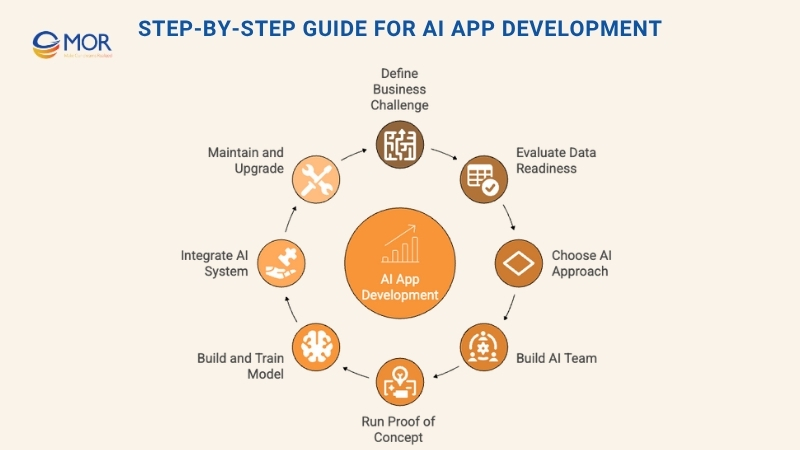
1. Define The Business Challenge
The foundation of any AI for app development initiative is a well-defined problem. The goal isn’t to add AI just for novelty, it’s to create tangible business value through growth, efficiency, or improved customer experience.
Start by clarifying:
- What exact challenge are we addressing? (for example, high churn, rising costs, or slow delivery cycles)
- What measurable result do we expect? (for example, reduce churn by 10%, shorten production time by 15%)
Each target should be clear, measurable, and connected to operational outcomes. We always recommend setting SMART goals, Specific, Measurable, Achievable, Relevant, and Time-bound, to keep projects grounded in business reality.
It also helps to conduct a discovery session with stakeholders before development begins. This step aligns expectations, defines priorities, and uncovers potential risks early, saving time and cost later.
Once objectives are set, it’s crucial to validate whether transfer learning is the right solution. A feasibility study helps confirm if machine learning or automation can truly achieve the desired results. This approach ensures the investment drives long-term business value, not short-term experimentation.
Examples Of AI Aligned With Business Goals
Business Request | Objective | AI Capability | Example Outcome |
Forecast next quarter’s sales | Predict demand | Forecasting | More accurate revenue planning |
Identify why users leave carts | Reduce churn | Impact analysis | 10% conversion rate improvement |
Segment audiences | Increase marketing ROI | Clustering | Better campaign targeting |
Analyze feedback tone | Improve retention | Sentiment classification | Faster response to negative feedback |
Detect purchase trends | Support upsell/cross-sell | Association | Higher average order value |
Spot unusual transactions | Prevent fraud | Anomaly detection | Lower financial losses |
A clear problem definition keeps your AI app development project focused, measurable, and tied directly to business performance.
2. Evaluate Data Readiness
The success of AI app development depends heavily on the data feeding it. High-quality, relevant, and well-managed information is essential for accuracy and return on investment. Before moving forward, every organization should evaluate whether its data ecosystem is ready to support intelligent solutions.
Here’s a standard process for preparing data in AI app building projects:
- Review existing data: Take inventory of what’s already available, assessing completeness, consistency, and accessibility. This may include customer databases, transaction logs, CRM solutions, IoT sensors, or verified public datasets.
- Identify and fill gaps: If current data doesn’t meet project requirements, plan to collect, purchase, or ethically generate missing information. For example, forecasting tools might require historical sales data, while customer-facing AI may need behavioral or sentiment datasets.
- Build compliance and governance: Establish policies for responsible data use and ensure adherence to privacy laws such as GDPR and CCPA. Strong governance protects your brand and fosters user confidence.
Weak data foundations lead to inaccurate predictions and low system reliability. Understanding data’s influence in AI app development helps ensure the final product delivers measurable business value.
Examples Of AI Use Cases And Data Requirements
AI Application | Data Sources | Business Outcome |
Forecasting | Market reports, internal sales records | Better revenue forecasting and ROI visibility |
Impact analysis | Customer journey data, product analytics | Clearer understanding of churn or conversion drivers |
Clustering | Demographic info, purchase history | Sharper segmentation for personalized marketing |
Classification | Feedback, transactions, support tickets | Automated support, sentiment detection, or intent prediction |
Association | Retail purchase data, consumer trends | Stronger cross-sell and upsell targeting |
Anomaly detection | Sensor data, transaction logs, network traffic | Early detection of fraud or equipment issues |
Clean, compliant, and structured data lays the foundation for scalable, high-performing AI app development outcomes.
3. Choose Between Custom And Pre-Built AI
The next decision in AI app development is selecting the right approach, building a custom model from scratch or integrating pre-built APIs and cloud-based best automation tools. Your budget, timeline, and business priorities will shape which path makes the most sense.
Custom AI App Development
- Involves higher cost and longer development cycles but delivers full ownership and flexibility.
- Ideal when AI sits at the core of your product strategy or when you need specialized functionality competitors can’t easily duplicate.
- Creates a long-term competitive advantage since the model is trained on your proprietary data and tailored to your business logic.
Pre-Built APIs And Cloud Platforms
- Faster and more affordable to deploy, suitable for supporting tasks like chatbots, visual search, or speech recognition.
- Easy to connect using services from providers such as OpenAI, Google Cloud, or IBM Watson through simple API integration.
- The trade-off: limited customization, so outcomes may resemble others using the same platform.
In short, if AI defines your business model, a custom solution is the smarter route. But when you only need complementary features, pre-built options let you AI create application functionality quickly, minimizing development time and cost.
4. Build The Ideal AI Development Team
The strength of your AI app development project depends on the people driving it. A skilled, well-structured team ensures the system not only works but delivers measurable business results. A typical setup includes:
- Product Manager – Keeps the project aligned with strategic goals, defines priorities, and measures success against ROI.
- Data Scientist – Interprets data, designs experiments, and validates that models deliver practical value.
- Machine Learning Engineer – Builds, trains, and fine-tunes AI agent frameworks, ensuring performance in real-world conditions.
- Data Engineer – Manages data pipelines, storage systems, and infrastructure to keep information accurate and accessible.
Together, these roles balance technical execution, analytics, and business strategy. Depending on your capabilities, you can either hire in-house experts or collaborate with an experienced AI app development company to speed up delivery and access advanced skill sets.
In-House vs. Outsourced Teams
Building an internal team gives you full control but requires large investments in hiring, infrastructure, and ongoing training. Outsourcing, on the other hand, provides instant access to specialized expertise and proven development processes, ideal if your organization needs quick results or lacks AI-specific talent.
Hybrid Models
Many companies today combine both approaches. They keep core management and sensitive data in-house while outsourcing complex tasks such as model prototyping or infrastructure setup. This flexible model maintains control while scaling resources efficiently.
Comparison Of Hiring Models
Model | Cost | Expertise | Control | Best For |
In-house | High (salaries, infrastructure, training) | Dependent on internal hiring capacity | Full ownership of data and strategy | Long-term projects central to your business |
Outsourced | More flexible, lower upfront | Direct access to AI specialists | Managed through vendor agreements | Fast delivery or when lacking in-house expertise |
Hybrid | Balanced cost and flexibility | Access to niche expertise as needed | Strong strategic oversight | Businesses seeking both control and scalability |
In most cases, a hybrid setup provides the best balance, letting your AI app developers work alongside external experts for faster, smarter outcomes without losing ownership of your core vision.
5. Run A Proof Of Concept (PoC)
When starting AI app development, it’s smarter to test small before scaling big. Rather than reworking an entire system, choose one process or dataset where AI can show clear, measurable improvement. This approach lowers risk while giving early insight into what truly drives value.
A Proof of Concept (PoC) helps validate feasibility, confirming that your AI model performs accurately with your organization’s real data. It also allows teams to gauge potential ROI, whether through reduced manual work, lower costs, or better accuracy. Engaging end users at this stage ensures the solution addresses actual needs, not just technical goals.
Once complete, the PoC’s findings guide your next move. Use these results to refine scope, validate success criteria, and prioritize where to expand. That way, scaling becomes a strategic decision grounded in data, not assumptions. A focused pilot is often the difference between experimental AI app development and a proven, scalable business solution.
6. Build And Train The AI Model
At this stage of AI app development, your team focuses on creating, fine-tuning, and validating the model to ensure it delivers real business value. Building the model isn’t just a technical task, it’s about aligning performance with strategic outcomes.
Keep three priorities in mind during model training:
- Accuracy With Purpose: The model should be precise enough to achieve tangible business goals, like predicting demand, improving service quality, or reducing churn. Chasing perfect accuracy often leads to diminishing returns that don’t translate into meaningful ROI.
- Fairness And Transparency: Every AI app developer must consider bias prevention and explainability. Modern AI systems should produce outcomes that are fair, consistent, and easy for stakeholders to understand, not hidden behind a “black box.”
- Balanced Performance And Efficiency: Each improvement in accuracy requires extra data, compute power, and time. Decision-makers should always evaluate whether higher precision justifies the added cost or if the model is already “good enough” to create measurable value.
An effective model strikes the right balance, accurate, ethical, and efficient, so your AI solution performs reliably in real-world conditions.
7. Integrate The AI System Into Workflows
The true impact of AI app development is realized only when the solution becomes part of daily business operations. Success depends on smooth deployment, user adoption, and ongoing monitoring to ensure the model keeps delivering measurable results.
Executives should focus on three core priorities:
- Smooth System Integration: The evolutionary algorithms must connect effortlessly with existing systems like CRM, ERP, accounting, or customer support tools. This ensures uninterrupted data flow and allows employees to use AI insights within familiar environments. For customer-facing solutions, seamless rollout through app stores such as Apple App Store or Google Play ensures visibility and accessibility.
- User-Focused Design For Adoption: Even the best model fails if users don’t engage with it. Interfaces should be intuitive, outputs clear, and workflows aligned with how employees actually work. An AI application builder mindset, focused on usability and simplicity, helps bridge the gap between technical complexity and everyday use.
- Change Management And Trust: Deploying AI often transforms internal processes. Communicate openly, train staff, and provide ongoing support so users understand how the system helps them, not replaces them. Building confidence in AI outputs is essential for long-term adoption.
After deployment, continuous evaluation is key. Regularly review the model’s accuracy, fairness, and performance to keep it aligned with changing data and business goals. Successful AI app development doesn’t end at launch, it continues as the system evolves with your organization.
8. Maintain And Upgrade The AI App
Once an AI model proves reliable and delivers consistent results, the next goal is expansion. Scalable AI app development means extending its capabilities to new departments, workflows, or customer touchpoints, transforming a single-use pilot into a long-term growth engine.
User feedback plays a central role in this phase. It helps identify where the system adds the most value and where fine-tuning is needed to ensure ongoing adoption and performance.
That said, AI is never a “build once and walk away” investment. Businesses must continually review compliance, fairness, and transparency as privacy regulations like GDPR and CCPA evolve. Maintaining a strong governance framework protects both customers and company reputation.
Another challenge is model drift, the gradual decline in accuracy when real-world data changes over time. To prevent this, teams should routinely retrain models, refresh datasets, and recalibrate algorithms. Continuous monitoring ensures predictions stay relevant and reliable.
Partnering with an experienced AI app development company or maintenance provider can simplify this process. Regular updates, audits, and optimization cycles help keep systems compliant, cost-effective, and high-performing, allowing your internal teams to stay focused on innovation and business growth.
Six AI App Development Best Practices
Strong AI app development requires more than just technical expertise. Building a scalable, secure, and user-focused product takes structure, iteration, and constant improvement. The following best practices can help teams create reliable and future-ready applications.
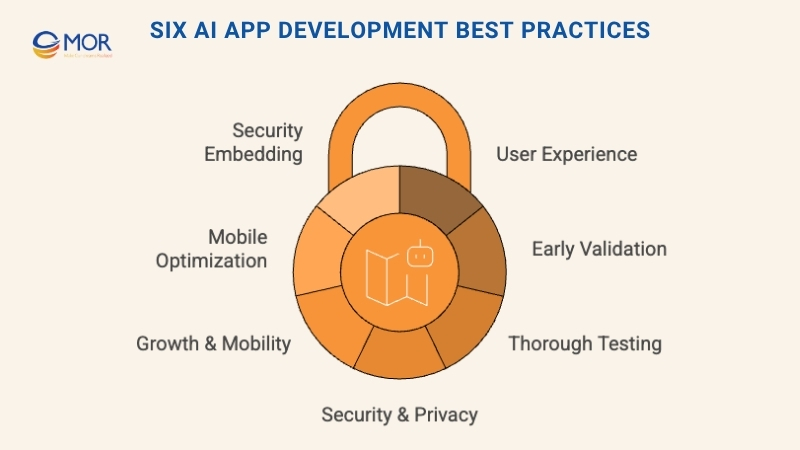
Focus On The User Experience
AI should simplify the experience, not make it harder. Keep interfaces intuitive and ensure users understand how intelligent features work. During design, emphasize clarity, explain how recommendations are generated and give users control over automation settings. Continuous UI testing helps confirm that the app feels natural and easy to navigate.
Validate Early With Prototypes
Before moving into full production, build quick prototypes to test functionality and gather user feedback. This early step saves time, prevents costly rework, and ensures the app aligns with real user needs. Whether you’re working with an internal team or a professional AI app development company, early validation helps refine both design and performance.
Test Thoroughly Before Release
Comprehensive testing is essential for stability and trust. Conduct unit, integration, and user acceptance tests to uncover bugs, security flaws, or performance issues before launch. By addressing these early, your AI app building process delivers smoother rollouts, higher reliability, and a better end-user experience.
Prioritize Security And Privacy
From the very beginning of AI app development, security must be treated as a core requirement, not an afterthought. Apply end-to-end encryption, secure APIs, and real-time monitoring to protect sensitive information. Regular security audits help detect vulnerabilities early and maintain user trust. Compliance with privacy regulations such as GDPR and CCPA is equally important. Adopting a privacy-by-design approach ensures transparency, consent, and accountability are built into every interaction.
Build For Growth And Mobility
As usage scales, so do data demands. Choose cloud-native architectures and flexible frameworks that allow your app to expand seamlessly without major restructuring. Scalable AI software builder platforms make it easier to handle large volumes of data and traffic while maintaining consistent performance.
Optimize AI For Mobile Platforms
When developing mobile solutions, focus on performance efficiency. Use lightweight models or shift intensive processing to the cloud to preserve device speed and battery life. Frameworks like Pytorch vs Tensorflow Lite and ONNX are valuable for deploying compact, high-performing AI on mobile devices. This balance keeps your application responsive, reliable, and user-friendly across all environments.
Embed Security In Every Phase (DevSecOps)
Given the sensitive data that powers AI systems, security must be woven into every stage of AI app development. Adopting a DevSecOps mindset means building protection directly into your workflows, from initial design through deployment and maintenance. This approach helps safeguard user data, prevent vulnerabilities, and ensure lasting trust.
- Shift Security Left: Introduce security checks early in development. Use automated scanning, vulnerability testing, and AI-driven threat detection inside your CI/CD pipeline to spot and fix issues before release.
- Maintain Continuous Monitoring And Compliance: Real-time visibility is essential. AI-enabled monitoring tools can detect anomalies, stop data breaches, and keep your app compliant with privacy standards like GDPR and CCPA.
- Automate Security Controls: Implement automation for tasks such as access management, identity verification, and vulnerability assessments. Automation minimizes human error and maintains consistent protection across all environments.
- Encourage Team Collaboration: A DevSecOps culture connects developers, security experts, and operations teams from day one. This ensures that AI models, APIs, and data workflows are secure by design rather than retrofitted later.
- Invest In Security Training: Keep your AI app developers informed about new cyber threats, ethical AI practices, and secure coding methods. Ongoing education builds a proactive security culture and strengthens every layer of your development lifecycle.
Major Challenges In AI App Development
Anyone working on AI app development quickly discovers that the process brings its own set of technical and ethical challenges. These issues often shape how successful, reliable, and scalable an AI solution becomes. Below are two of the most common obstacles and how to overcome them.
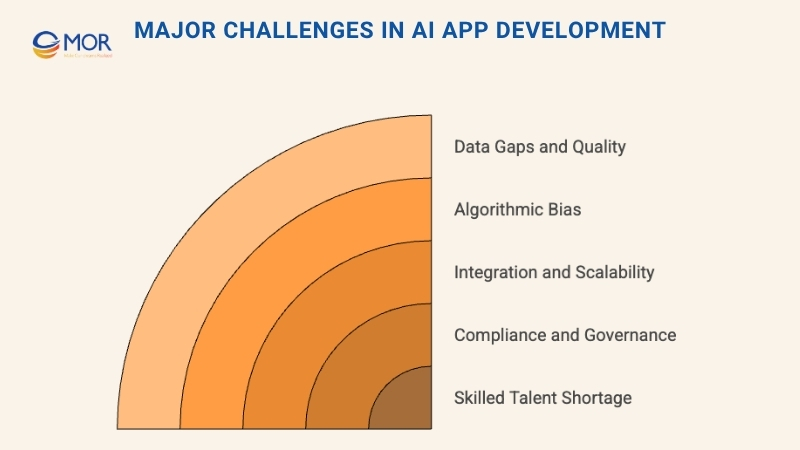
Data Gaps And Quality Issues
AI models rely on large volumes of accurate and relevant data, yet many organizations still struggle with limited or inconsistent datasets. Poor data quality leads to unreliable predictions, weak automation, and lost business opportunities.
How to address it: Partner with trusted data providers or collaborate across your industry to expand access to reliable sources. Invest in advanced data cleansing, validation, and augmentation techniques to strengthen model performance and long-term scalability in AI app development.
Algorithmic Bias
Machine learning systems can unintentionally replicate or amplify bias found in their training data, leading to unfair or inaccurate outcomes. This not only damages brand reputation but can also trigger regulatory scrutiny.
How to address it: Use diverse training datasets, apply automated bias-detection tools, and include external reviewers or domain experts to identify hidden bias early. By ensuring fairness and transparency, you strengthen trust in both your data and your AI-driven decisions.
Integration And Scalability
Many AI app development projects struggle to move past the pilot stage because they fail to integrate smoothly with existing systems or scale effectively as data and user demands increase.
How to solve it: Design with flexibility in mind. Use modular architectures and cloud-based platforms to ensure easy scaling and seamless connection with current tools. Collaborating with skilled DevOps engineers helps automate deployment and maintain stability as your AI solution grows.
Compliance And Governance
Evolving laws around privacy, data use, and ethics make compliance an ongoing challenge, particularly for organizations operating in multiple regions.
How to solve it: Embed transparency and accountability into every layer of your AI system. Involve legal and compliance experts early in development, and schedule regular audits to stay aligned with regulations such as GDPR and CCPA.
Shortage Of Skilled Talent
The global shortage of qualified AI professionals continues to limit innovation and increase hiring costs. Keeping experienced engineers engaged requires more than compensation alone.
How to solve it: Foster a culture of innovation and continuous learning. Provide training in new technologies and frameworks, and when needed, partner with an established AI app development company to access specialized expertise without slowing progress.
Estimating The Cost Of AI App Development
The cost of AI app development usually ranges from $30,000 to $150,000, depending on the app’s complexity, data requirements, and infrastructure setup. Lightweight applications that rely on pre-trained APIs can start from a few thousand dollars, while fully customized, enterprise-level solutions can exceed $1 million.
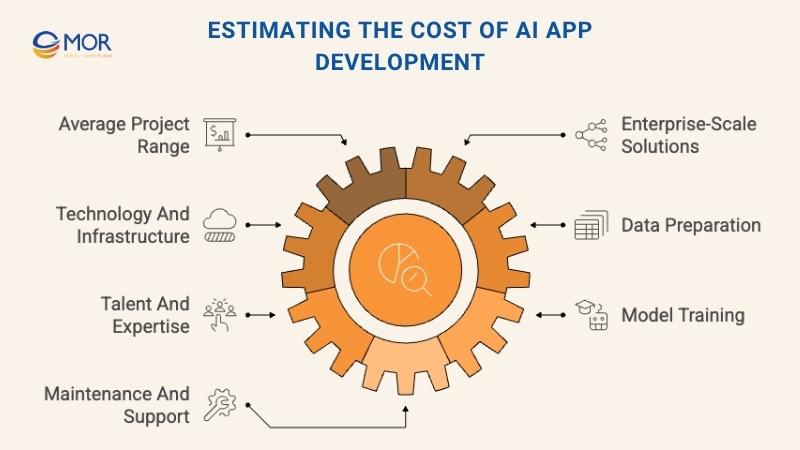
If you need a deeper breakdown, our custom software cost guide explores detailed pricing models. Below, we’ll focus on the key factors that shape AI project budgets.
Technology And Infrastructure
Your technology stack has the biggest influence on cost. Using pre-built APIs or cloud AI development services is the most affordable option. Entry-level pricing can be as low as fractions of a cent per request, for example, NLP services start around $0.004 per request. This route is ideal for startups or teams testing early use cases since it’s easy to scale and maintain, though it offers less room for customization.
For businesses that make AI part of their core strategy, investing in custom infrastructure delivers better control and performance. High-end GPUs can cost more than $10,000 each, or several dollars per hour to rent, depending on usage. While this increases upfront costs, it supports greater accuracy, scalability, and independence, especially when developing proprietary systems with a trusted AI app development company.
Sample Cloud API Pricing
Provider / AI Service Type | AWS AI | Google Cloud AI | Azure AI |
Computer Vision | From $0.001/image or $2/hour | From $4.84/hour | From $1/1,000 transactions |
NLP | From $0.004/request or $0.01/min | From $8.35/1,000 records | From $1/1,000 records |
Forecasting | From $0.20/1,000 data points | From $0.08/node hour | From $3.75/30 time series |
Estimated Custom Infrastructure Costs
Hardware Type | Approximate Cost |
GPU | $10K per unit (e.g., Nvidia A100) or $1.14/hour to rent |
FPGA | $5K–$100K, depending on performance |
ASIC | Starts at $150K |
Choosing between cloud-based APIs and custom infrastructure depends on your budget, scalability needs, and how central AI is to your business model.
Data Preparation
Data plays a central role in every AI app development project, and preparing it properly often represents a large share of the total budget. Research from Dimensional Research indicates that machine learning models typically require around 100,000 high-quality samples to perform effectively. Depending on your existing datasets and goals, building a complete training set can cost between $10,000 and $85,000 or more, accounting for data collection, cleaning, labeling, and annotation.
Talent
Skilled professionals are another key cost driver. The salaries of AI and ML specialists vary by location and experience level:
- North America: $40,000–$112,000 per AI/ML engineer annually
- Eastern Europe or Latin America: $30,000–$75,000 for comparable expertise
Partnering with an experienced AI app development company can lower total expenses by 40–60%, providing access to seasoned engineers, data scientists, and project managers without the overhead of building a full in-house team.
AI Model Training
Training is one of the most resource-intensive phases in AI app development, and costs rise quickly with model complexity and dataset size. While simpler models can be trained for a few thousand dollars, advanced large-scale systems may require investments reaching into the millions.
A Medium analysis comparing cloud training costs offers helpful perspective. Using Hugging Face’s BERT model with a 5 GB dataset, 100 epochs, and a batch size of 64, here’s how various AWS instances compare:
Instance (AWS) | Estimated Training Time | Estimated Cost |
c5.2xlarge.od | 12.88 hours | $4.38 |
c4.large.od | 46.23 hours | $4.62 |
c6g.8xlarge.od | 6.19 hours | $6.75 |
c6g.medium.od | 248.33 hours | $7.48 |
c6i.large.od | 85.73 hours | $7.72 |
Training efficiency depends on both hardware selection and optimization techniques. Partnering with experienced machine learning engineer can help balance training time, computational cost, and performance, ensuring your investment yields the best results without unnecessary spending.
Maintenance
After deployment, ongoing maintenance remains a major part of AI app development costs. Most organizations allocate 25–75% of the original project budget to post-launch needs such as monitoring performance, retraining models, updating for compliance, and providing technical support.
These continuous efforts keep the system accurate, secure, and aligned with evolving business goals. Partnering with a reliable AI app development company for maintenance ensures long-term stability and reduces the risk of performance drift or unexpected downtime.
AI App Development Cost Overview
Understanding the full picture of AI app development cost helps businesses plan budgets more effectively and avoid hidden expenses. Below is a breakdown of the key cost factors, typical ranges, and how each one impacts long-term ROI.
Category | Typical Range | ROI Perspective |
Technology & Infrastructure | From less than $0.01 per API call to over $10K per GPU (or $2–$10/hour for cloud rental) | Cloud APIs provide quick, low-cost access; custom infrastructure requires higher investment but delivers stronger differentiation when AI is central to your business. |
Data (Collection & Preparation) | $10K–$85K+, depending on volume and complexity | Clean, well-labeled data boosts accuracy and prevents costly retraining or performance issues later on. |
Talent (In-House vs. Outsourcing) | $25K–$50K per year for outsourced engineers in Eastern Europe or Latin America, up to $90K–$112K+ in North America | Outsourcing can cut costs by 40–60% while tapping into senior expertise; in-house teams offer control but at higher long-term expense. |
Model Training & Iteration | Ranges from thousands to millions, based on model complexity and data scale | Focus on efficiency, seek strong performance without over-spending for minimal accuracy improvements. |
Ongoing Operations & Maintenance | 25–75% of the initial build cost annually | Regular monitoring, retraining, and compliance updates maintain accuracy, trust, and positive ROI over time. |
A clear understanding of these cost drivers helps businesses plan smarter budgets and work with an experienced AI app development company to achieve both efficiency and long-term value.
How To Choose The Best AI App Development Company?
Selecting the right partner for AI app development is a decision that can define your project’s success. The right company not only delivers technical excellence but also ensures your investment turns into measurable business value. Here’s what to consider when evaluating potential partners.
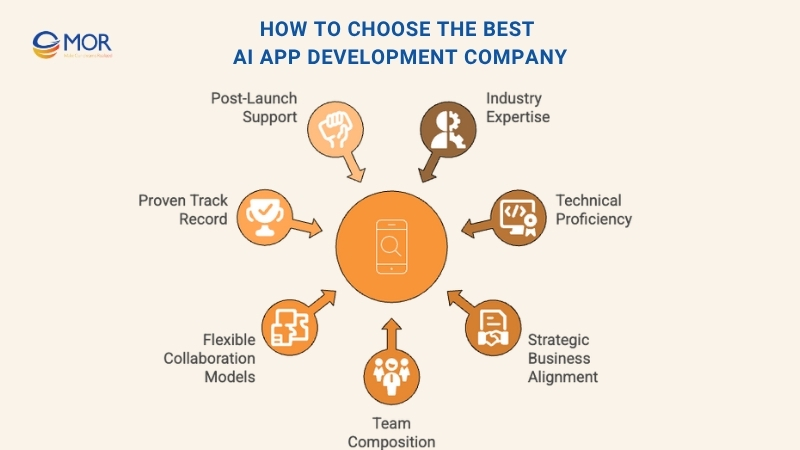
Industry Expertise
Experience within your sector matters. A reliable partner should understand your market challenges and apply proven solutions. At MOR Software JSC, we’ve built AI-driven systems for industries such as retail, healthcare, finance, education, and travel, helping each client turn complex goals into practical, scalable outcomes.
Technical Proficiency
Your partner should demonstrate mastery in key AI fields, including machine learning, natural language processing tools, computer vision, and predictive analytics. MOR’s engineers specialize across these domains and constantly stay current with evolving technologies, ensuring every project uses the most effective and modern tools available.
Strategic Business Alignment
AI should directly contribute to growth, not just exist as a technical experiment. We start each project with a discovery session to align technology with your business strategy and ROI targets, ensuring the solution serves long-term objectives rather than short-term trends.
Team Composition
Strong AI projects require more than coding expertise. A complete team should include product managers, data scientists, ML engineers, and testers. MOR Software provides full, dedicated teams or individual experts who can integrate seamlessly with your in-house staff.
Flexible Collaboration Models
Look for a partner that adapts to your structure. We offer engagement models such as dedicated teams, project-based contracts, or hybrid arrangements, allowing you to scale up or down as your needs evolve.
Proven Track Record
Always verify credibility. Case studies, client testimonials, and independent reviews reflect real performance. MOR Software has delivered 850+ successful projects globally, maintaining long-term partnerships built on trust and consistent delivery.
Post-Launch Support
AI systems require continuous refinement. Our team provides ongoing maintenance, retraining, and compliance updates to keep your app secure, accurate, and efficient as business needs evolve.
Partnering with an experienced AI app development company ensures your project remains innovative, sustainable, and strategically aligned from day one through post-launch growth.
Future Trends In AI App Development (2026 And Beyond)
By 2025, the AI app development landscape has grown far more competitive. The technology has matured, but it has also become easier to access, thanks to smaller and lighter models that can run efficiently on local or edge devices.
As the hype fades, companies are shifting focus from experimentation to real-world applications, investing in AI that drives measurable results. This shift opens opportunities for specialized, industry-specific solutions that address niche needs rather than broad, generic use cases.
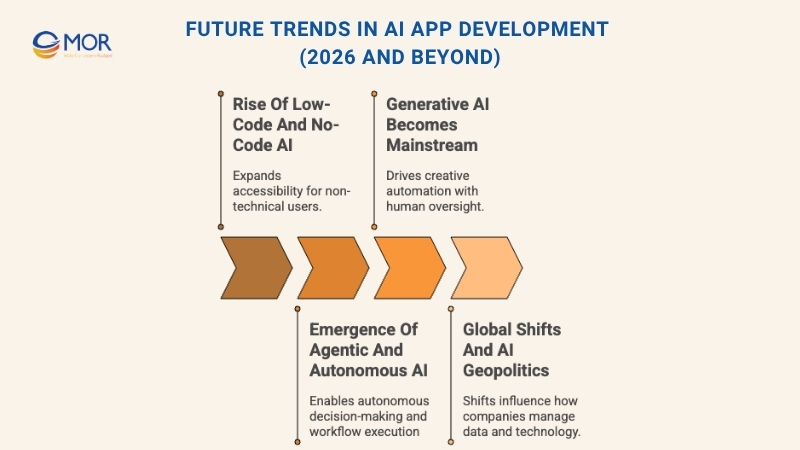
Rise Of Low-Code And No-Code AI
Low-code and no-code tools are making AI app development more inclusive, allowing non-technical teams to build and test simple applications without writing code. These platforms accelerate innovation and help businesses prototype faster.
Still, their purpose is complementary. For complex projects that demand advanced customization, full-scale development remains essential. As accessibility grows, organizations are combining both methods, using no-code AI for rapid experimentation and traditional engineering for scalable, enterprise-grade solutions.
In short, these AI software builder platforms will continue to democratize development, helping businesses of all sizes bring ideas to life faster while maintaining room for deeper innovation where it matters most.
Emergence Of Agentic And Autonomous AI
Agentic AI represents the next step in AI app development, moving beyond traditional chatbots or copilots to handle full, multi-step workflows. These intelligent agents can connect multiple systems, make decisions, and execute tasks independently, reducing manual effort and saving valuable time across departments.
For now, the safest way to apply this technology is through controlled pilot projects such as customer service routing, document processing, or internal workflow management. Over the next few years, these autonomous agents will begin shaping core business functions like operations, logistics, and analytics.
For most organizations, the best strategy is to adopt agentic AI through trusted platforms or technology partners rather than building everything internally. Working with an experienced AI app development company allows faster deployment, lower costs, and access to specialized expertise, ensuring your business is ready to scale when agentic AI becomes mainstream.
Generative AI Becomes Mainstream
Generative AI is quickly evolving from an experimental tool to a core part of AI app development and enterprise strategy. Some organizations have already gone all in, automating content creation, support, and parts of product design. Others remain cautious, concerned about accuracy, ethics, and compliance.
In the coming years, a balanced approach will dominate. Generative AI won’t replace people, it will complement them. Much like cloud computing and CRM systems became essential layers in business operations, generative AI will integrate as a trusted productivity engine across departments. Companies that manage innovation with proper oversight will hold a clear competitive edge.
Key developments to watch:
- Governance And Trust – Defined usage rules, compliance monitoring, and brand protection will become standard practice.
- Hybrid Workflows – AI will handle the first draft, while humans review and refine the outcome.
- ROI-Based Adoption – Executives will approve AI projects that clearly demonstrate measurable business value, from cost savings to faster output.
- Specialization – Businesses will move away from generic tools toward industry-specific solutions built through tailored AI app development services for sectors like healthcare, finance, and retail.
Global Shifts And AI Geopolitics
Artificial intelligence is quickly becoming a strategic instrument of global influence. Nations are investing heavily in AI to gain economic and technological advantages, while also using trade policies and access restrictions on chips, data, and cloud infrastructure to shape competition. Control over AI hardware and data ecosystems is emerging as a defining factor in geopolitical power.
For companies engaged in AI app development, this means that supply chains, compliance requirements, and market access are no longer purely operational issues, they’re strategic ones. AI-related export controls and regional data laws can determine where businesses build, host, or distribute their technology.
Looking ahead to 2026 and beyond, organizations will need to diversify suppliers, strengthen compliance systems, and prepare for new trade and data regulations. The businesses that stay agile and plan for these geopolitical shifts will be the ones that remain competitive in an increasingly fragmented AI-driven world.
Why Choose MOR Software For AI App Development?
MOR Software has established itself as a trusted partner for AI app development, delivering smart, data-driven custom AI solutions that help enterprises innovate, automate, and scale efficiently. With a strong engineering foundation and offices across Vietnam and Japan, we combine local expertise with global standards to build AI-powered applications that solve real business problems.
Our specialists excel in machine learning, predictive analytics, computer vision, and natural language processing (NLP). We design AI apps that optimize workflows, enhance decision-making, and personalize user experiences across industries such as finance, healthcare, retail CRM, and manufacturing. Each solution is tailored to improve performance and align with measurable business outcomes.
What defines MOR Software’s approach is our end-to-end development process. From strategy and data preparation to deployment and post-launch optimization, our teams work with Agile methodology and version-controlled CI/CD pipelines. This ensures every AI model we build is secure, scalable, and continuously adaptive to business growth.
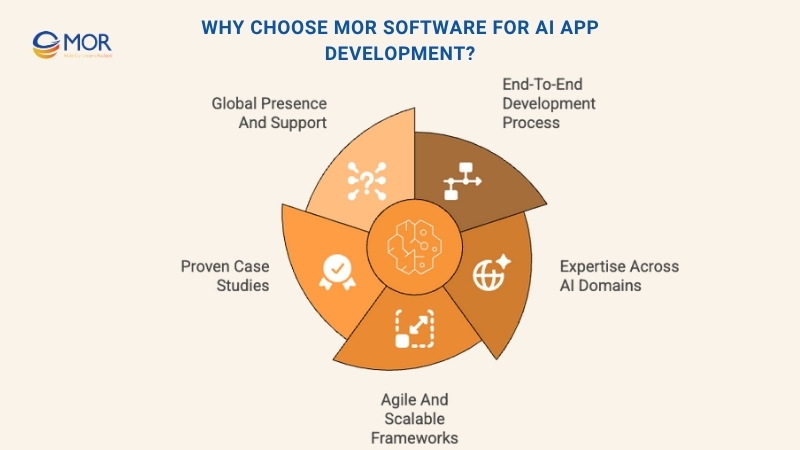
Our AI case studies reflect the depth of our expertise. For example, we built a spam detection model for a healthcare platform that improved data reliability and user trust. In another project, our AI-driven mobile solution for a Japanese construction company streamlined communication, reporting, and on-site coordination through smart automation and real-time collaboration features.
At MOR Software, we don’t just develop AI applications, we create intelligent ecosystems that deliver long-term value. Whether you’re exploring automation, predictive analytics, or full-scale AI transformation, our experts can guide you from concept to deployment with precision and care.
Ready to bring your AI app idea to life? Contact us today to start your project with MOR Software.
Conclusion
AI is no longer optional. It’s the foundation of digital growth. With the right AI app development strategy, businesses can automate smarter, innovate faster, and compete stronger. MOR Software helps you achieve that with end-to-end expertise in data, design, and deployment. Whether you’re building your first intelligent product or scaling existing systems, our team delivers measurable impact. Contact MOR Software today to turn your AI vision into a solution that drives lasting business value.
MOR SOFTWARE
Frequently Asked Questions (FAQs)
What is AI app development?
AI app development involves creating applications that use artificial intelligence technologies like machine learning, natural language processing, or computer vision to perform tasks that normally require human intelligence.
How does AI improve traditional app functionality?
AI adds automation, predictive insights, and personalization to traditional apps, enabling smarter decision-making, faster operations, and better user experiences.
What industries benefit most from AI applications?
Industries such as healthcare, finance, retail, manufacturing, logistics, and education see major gains from AI solutions through process automation and data-based optimization.
What technologies are commonly used in AI app development?
Developers often use tools like TensorFlow, PyTorch, OpenAI APIs, AWS AI, Google Cloud AI, and Azure Cognitive Services for model training, deployment, and automation.
How long does it take to build an AI-powered application?
Development time depends on complexity and scope. Simple AI apps may take 3–6 months, while enterprise-grade platforms can take 9–18 months, including testing and deployment.
What are the key stages of AI app development?
Typical stages include data collection and cleaning, model selection, training, testing, integration, and continuous monitoring to ensure long-term accuracy.
How much does it cost to develop an AI app?
Costs usually range from $30,000 to $150,000, depending on app complexity, data needs, and whether it’s a custom-built or pre-trained AI model.
What programming languages are best for AI applications?
Python is the most widely used due to its strong AI libraries, followed by Java, C++, R, and JavaScript for specific use cases like web integration or data visualization.
Can AI apps work without large datasets?
While large datasets improve accuracy, smaller projects can use pre-trained models or synthetic data generation to achieve good performance.
What are the biggest challenges in AI app development?
Common challenges include ensuring data quality, preventing algorithmic bias, maintaining scalability, and staying compliant with privacy laws.
How can businesses measure ROI from AI applications?
Key performance indicators include cost savings, process speed, accuracy improvements, customer retention rates, and increased revenue or efficiency.
Are AI apps secure?
Yes, when designed properly. Developers use encryption, access control, and real-time threat detection to protect sensitive data and prevent misuse.
What’s the difference between machine learning and AI?
AI is the broader concept of creating intelligent systems, while machine learning is a subset focused on training algorithms to learn from data and make predictions.
How often should AI models be retrained?
AI models should be retrained periodically, every few months or whenever new data patterns emerge, to maintain accuracy and relevance.
Can AI be integrated into existing business applications?
Absolutely. AI can be embedded into CRMs, ERPs, customer service tools, and mobile apps to enhance functionality without rebuilding entire systems.
Rate this article
0
over 5.0 based on 0 reviews
Your rating on this news:
Name
*Email
*Write your comment
*Send your comment
1